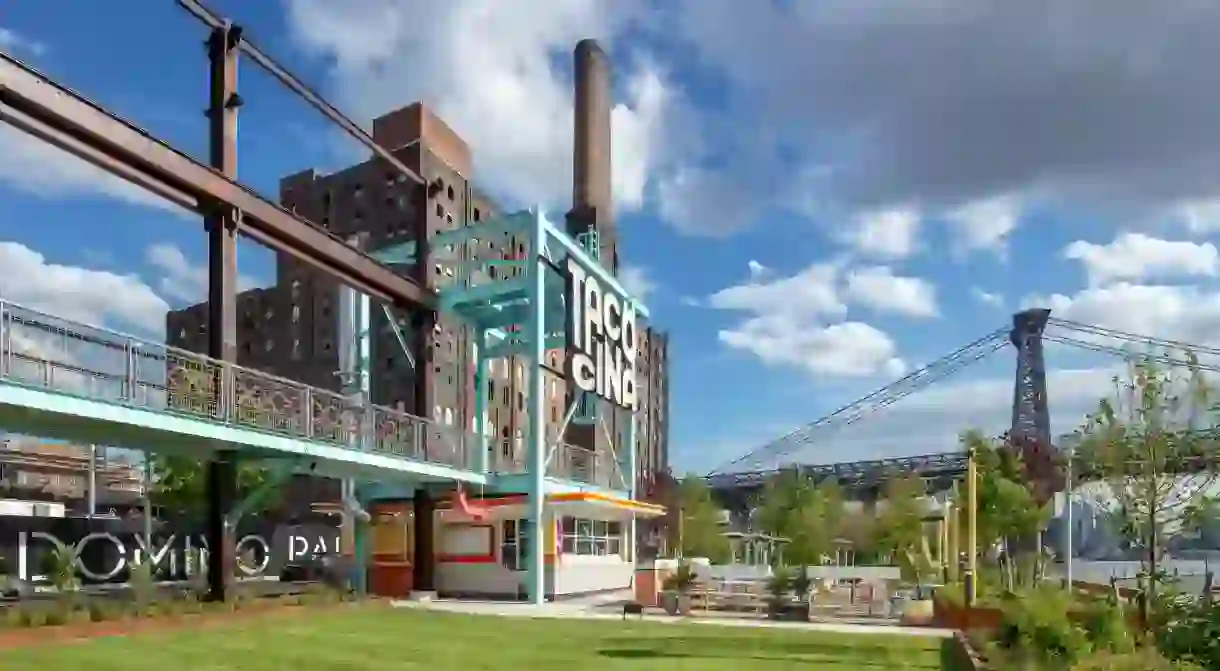Domino Park Adds a Touch of Sweetness to the Williamsburg Waterfront

Domino Park, a new public waterfront park in Brooklyn, opens after $50 million private investment in the historic sugar factory site.

“I have goosebumps today, seeing all the people here,” said Bonnie Campbell during Domino Park’s public opening on June 10. The managing director for Two Trees, the developers behind the project, Campbell added that the park is “definitely the coolest thing we’ve ever worked on.”
On a warm but slightly rainy day in South Williamsburg, everyone seems to be smiling—a rare sight to see in New York City. Children from all backgrounds and nationalities play together in the Sweetwater Playground, couples stroll the 1,200-foot-long waterfront esplanade, families line up for free gourmet ice cream sandwiches, and young people play beach volleyball and bocce in the recreational areas. These New Yorkers are experiencing a new side of Brooklyn, one they’ve never seen in their lifetime: a six-acre public waterfront park on the old Domino Sugar Factory site.
Built in 1856, the the factory produced four million pounds of sugar daily at its peak, supplying 98% of all the sugar consumed in the United States. While the company was well-known for ignoring hazardous conditions for workers and incurring labor strikes, demolishing the historic structure wasn’t in the cards. The building was landmarked by the city in 2007.

Two Trees Management bought the property in 2012, with plans to turn the site into a mixed-use community, including a redevelopment of the factory, which has been closed for over 14 years. Designed by SHoP Architects, the masterplan will boast a 380,000-square foot office campus (with a preserved facade incorporating the original factory sign), four residential buildings (with 700 affordable housing units), retail space, and a new public street. This complex will be spread out over 11 waterfront acres, with views of Manhattan and the Williamsburg Bridge.
Sanjukta Sen, a head designer for James Corner Field Operations, (the landscape architecture firm behind Domino Park’s design), said at the opening that one of her favorite elements is the public street that will separate the private residential buildings from the public space.
“It seems like a small thing, but it is really what makes [the park] truly public,” Sen told me. “It makes it really democratic, and that’s what I love. We were supported in that move by the clients [Two Trees], and that’s not something they had to do—it wasn’t mandated. Having this street as a true public connector, between the two edges of the development, is a huge deal.”

“I also love how we could save all these artifacts [from the Domino Factory], curate them and put them along this line [of the park], to give people a sense of the history here. Some of it is not necessarily savory history—there are associations with the sugar industry that people have problems with, but I think it’s interesting that these are monuments to that history,” Sen added.
The integration of the salvaged, industrial artifacts and architectural cues from the factory is one of the most interesting aspects of the park from a design perspective. Sweetwater Playground, for instance, uses the original factory’s color palette of teal, brushed metal, yellow, and green. It also includes formal elements from the interiors of the now-abandoned factory.
Brooklyn-based artist Mark Reigelman, who led the design for Sweetwater Playground, told me that it is the first-ever playground he has worked on.
With his newborn baby in tow, Reigelman beamed as he discussed the beginnings of the project: “When Two Trees first asked me to do this, I was, like, ‘I think they have playground designers, maybe you should talk to them.’ But they said, ‘No, we really want this to be artist-driven. We’ll surround you with a really good team of safety experts, engineers, architects, manufacturers. And the outcome is super exciting.”

Reigelman typically designs interactive, public works, but they tend to be more sculptural, with “more of a visual element within the landscape,” he said. “This level of interaction is something very new to me. Even seeing it right now is still kind of shocking and really rewarding: Seeing not just kids, but just as many dads going down these slides as you do children. I really wanted to design something that adults and parents would be just as excited to explore it with their families.”
Just like the designers from James Corner Field Operations, Reigelman also extracted formal elements from the factory to design the playground. “There were these stainless steel tubes running through it, all over the place, so that visual element was really important for me to capture,” he says.
The Sweetwater Silo, a main structure on the playground, reflects some of the large silos they would have had inside the factory, Reigelman pointed out, while the first entry ramp mirrors the long conveyor belt that originally connected the factory’s buildings. The idea for the Sugar Cane Cabin, another key element of the playground, was pulled from “this kind of weird cabin that would sit high up in front of the factory,” Reigelman explained.

Other highlights of the park include 585-feet of salvaged crane tracks, four giant original syrup tanks, an on-site cocktail and taco joint, dog park, recreational courts, and a 1,200-foot long waterfront esplanade that offers sweeping views of the Manhattan skyline and East River.
And while New York City is in no shortage of stories on the destructive impact of billionaire developers on communities, it seems—for now at least—this one got something right.

Domino Park is open every day from 6am to 1am. Visitors can access the park at South 5th Street, South 3rd Street, and Grand Street, and nearby trains include the L, J, and M lines.













